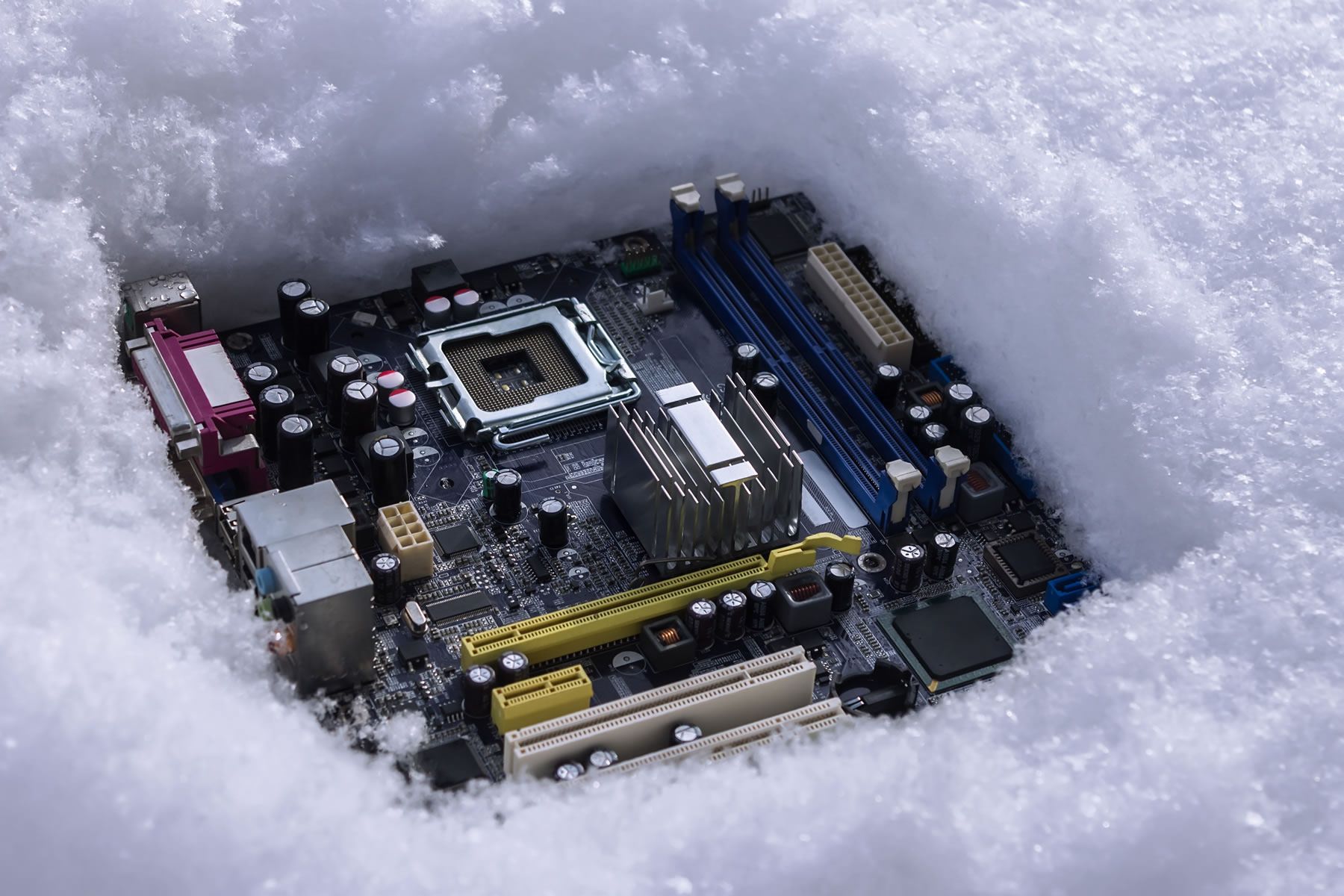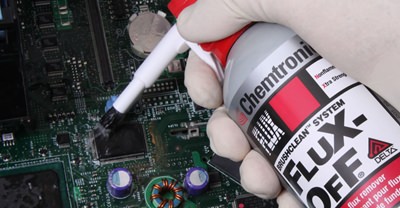The appearance of white residues on circuit boards is a recurring problem in PCB assembly, and generates many questions and complaints for the Tech Support hotline.
When contamination is found on the board after the cleaning step, the customer often assumes it has come from the cleaner itself. That, most likely, is not the cause. Usually residues form on circuit boards due to problems inherent in the nature of the soldering and cleaning process.
Chemtronics printed circuit board (PCB) cleaners, like Flux-Off flux removers and Electro-Wash maintenance cleaners, are filtered and made of 100% volatile solvents. That means they fully evaporate without leaving anything behind.
Most residues are the result of inadequate or partial cleaning, and can be eliminated by simply repeating the cleaning step. Unfortunately, there is another class of PCB residue that derives from more complex chemical reactions between the soldering flux, the cleaning solvents, the soldering process, the board laminate and certain process parameters, such a line speed and soldering temperature. These are the dreaded white residues, and often cannot be easily removed with conventional circuit board cleaners.
Types of PCB Residues
Circuit board residues fall into two broad categories:
Ionic residues
Ionic residues can cause corrosion if left on the board. The nature of the soldering flux, soldering process and cleaning parameters, or incompatibility with cleaning solvents can all lead to the formation of ionic residues. R, RA and aqueous fluxes will all leave ionic residues if not cleaned properly. No-clean fluxes are engineered to consume the ionic material when exposed to soldering temperature and activated. But any no-clean flux that isn’t fully activated can leave behind ionic residue much like any other flux.
Organic residues
Organic residues aren’t as serious, but spoil the appearance of the board and can lead to conformal coating adhesion problems. Organic residues can occur due to improper soldering or cleaning techniques or because of a mismatch between the flux and the specific flux remover.
It’s easy to determine the type of contamination you have on the board. Test each patch of residue with a drop of water. If the water dissolves the residue, it’s ionic. If not, test with a drop of isopropyl alcohol (IPA). If that dissolves the residue, it’s organic. This quickly tells you what it will take to clean the board (either a water-based cleaner or a solvent-based cleaner), and can give you some indication of what is causing the problem. In both cases, it’s more likely to be improper technique or incomplete cleaning that caused the contamination problem.
What Causes White Residue?
Ionic contamination often results from the type of soldering flux used. Rosin and rosin-based no-clean fluxes as well as many water-soluble fluxes contain varying amounts of halide acid activators. These activators give the fluxes greater heat stability, and help promote the formation of good solder joints by dissolving the oxide films contaminating copper, lead and tin surfaces.
The chemical reaction of chloride and bromide ions in these activators, with the lead in tin-lead solder, can cause the formation of white lead chloride and lead carbonate residue around the solder joints. If not completely removed during cleaning, these ions can establish a continuing corrosion cycle, producing more lead chloride and lead carbonate (white residue) and hydrochloric acid, which will attack the copper in the board laminate.
To make matters even worse, when current is applied, ionic particles can link together to form conductive branches called dendrites. Theses dendrites form between contact points and cause either current leakage or an electrical short.
Organic rosin residues can arise from a number of circumstances. Using old solvent that has been stored for some time can lead to incomplete cleaning. Isopropyl alcohol is used extensively in the industry as a flux remover and general PCB cleaner. IPA is hydroscopic so will absorb water from the air during prolonged storage. Heavily diluted IPA is a poor solvent for rosin-based fluxes, and will not dissolve heavy contamination without lengthy exposure time. Also the water in the solvent can react with no-clean fluxes, leading to even more white residue on the board.
In hand-soldering operations, there is a general tendency to use excessive amounts of flux or flux with high solids content. This can lead to a heavy build-up of contamination, which is not easily removed with a single-pass through the cleaning process.
Using too much flux can also lead to flux solution being trapped underneath components. Cleaning must be performed in a manner that flushes this contamination from beneath the components, otherwise partial removal will result in rosin contaminant draining across the board after initial cleaning has been completed. Increasing the residence time of the flux remover on the PCB can prevent this from happening.
How to Fix the White Residue Problem
The following are issues that can be addressed to eliminate the dreaded white residues from your PCB assemblies:
- Time between soldering and cleaning – The longer flux residues sit on the PCB, the harder they are to remove. We have consulted on cases where PCBs sitting over a weekend lead to unexpected white residues.
- Amount of flux used – Excessive flux or high solids content gives you that much more to remove. The variability of manual soldering make this a particular issue. Often best practice training will produce cleaner PCBs at the end of the line, even with no other change to the cleaning process.
- Flux choice – No-clean fluxes, especially the latest halide-free varieties, are much more difficult to clean compared to R and RA fluxes. If you plan to clean your PCBs, you are better off with R or RA flux that can be easily removed. Aqueous fluxes are a great choice if you have in-line or batch cleaning equipment, but very challenging for manual cleaning. Many solvent cleaners will not be effective on aqueous fluxes, and those types of fluxes are highly active, so they absolutely have to be removed.
- Solvency match – The better the solvency match you have between soil and cleaning solution the less effort needed, and the fewer headaches you’ll have. As a quick test, place a drop of cleaning solution on a PCB that has been coated with flux and run it through the reflow oven. After 1 or 2 minutes, wipe it off and see if it removed that area of the flux. If it does, it will then be a matter of developing an efficient cleaning process. If it doesn’t, find another cleaner that is more effective or you will be fighting it constantly. A general mismatch of the cleaner to the contamination type can be inferred by examining how the contamination coats the board. If the areas of residue are patchy in nature, then incomplete cleaning is indicated. Increasing the cleaning time and/or temperature should help. If the contamination appears as an even layer over the board surface, then you are not using the right cleaner for the residue present.
- Cleaner residence time – If you have a good solvency match, it is a matter of identifying the right amount of exposure time that is needed to fully clean the PCB. In an inline cleaning system, this would be achieved by adjusting the belt speed.
- Heating the cleaner – Generally speaking, solvency goes up with the temperature of the cleaning solution. Of course, this is not an option for flammable cleaners for safety reasons. Some cleaning equipment, like ultrasonic, batch and inline cleaning systems, allow you to adjust the temperature.
- Agitation in cleaning process – Finally, if solvency, exposure time, and temperature are fully optimized and you still have residues, you may need to add agitation. Agitation can come from a brush, wipe, swab, a forceful aerosol spray, ultrasonics, or jets in a cleaning system. In an in-line cleaning system, the position and pressure setting of the spray nozzle can also make a big difference in cleaning effectiveness.
Chemtronics offers solvent and water-based cleaners that are engineered to remove a wide variety of organic and inorganic residues. This gives you the flexibility to run different fluxes through the same cleaning process.
Chemtronics also has a fully equipped application lab and experienced lab technicians to help you identify problems and quickly find solutions. Our lab contains vapor degreaser, ultrasonic, batch cleaner and PVA selective spray equipment.
If you need help solving a white residue problem, or would like to develop a cleaning process that avoids the possibility of white residues, contact Chemtronics at [email protected] or 770-424-4888.
Ask A Technical Question
Stay up-to-date on Chemtronics news, products, videos & more.



